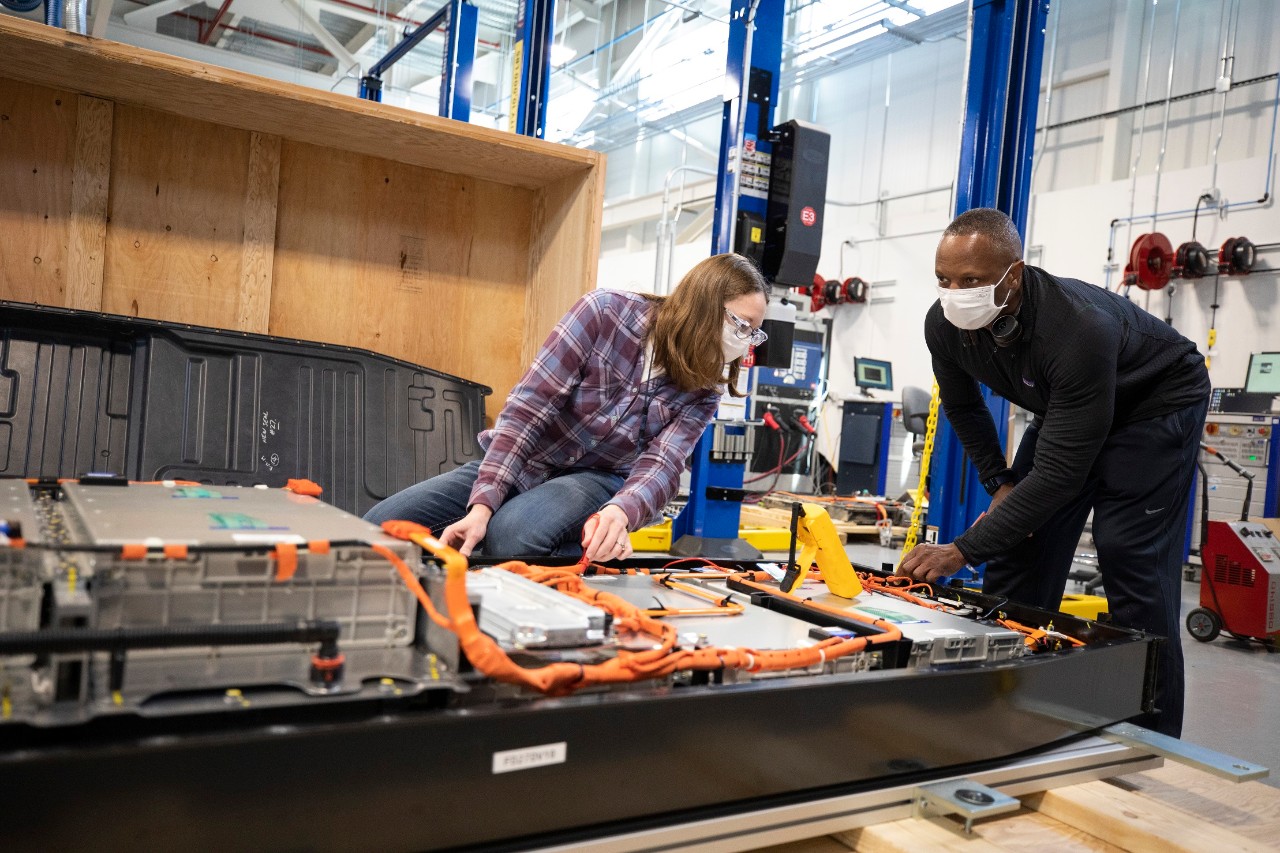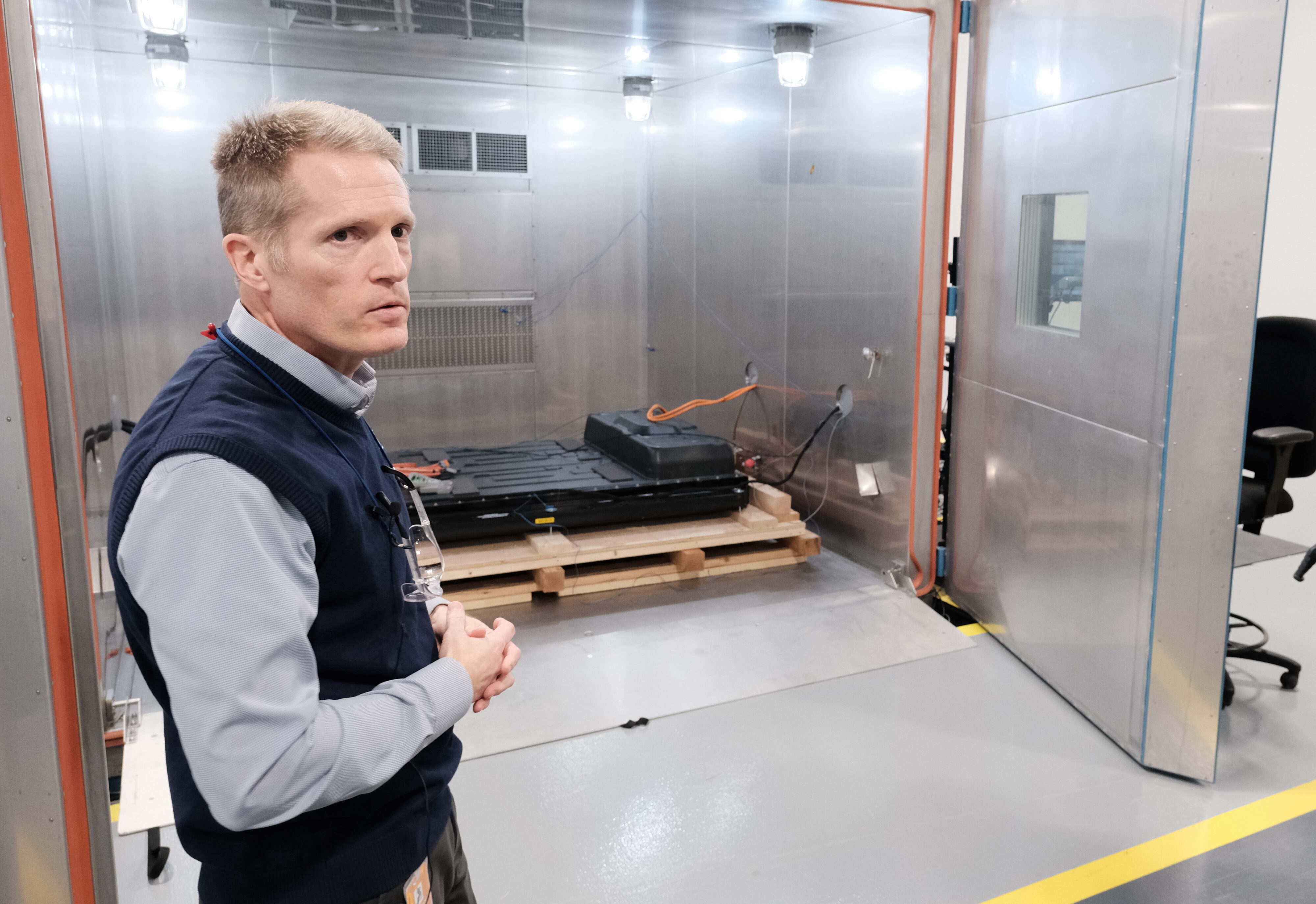
Courtesy of Ford Motor Company

Courtesy of Ford Motor Company
Electric vehicles (EVs) have emerged as a major solution to combat climate change, offering a promising alternative to traditional gas-powered cars. With brands like Ford, Tesla, and Rivian leading the charge, EVs have gained significant traction in recent years, captivating the attention of environmentally conscious consumers worldwide.
As someone accustomed to driving a gas car — or even a hybrid — the transition to a fully electric vehicle may seem like a leap into the unknown. Questions inevitably arise: If I’m not using gas, what exactly is powering my vehicle? To demystify the inner-workings of Ford’s EV technology specifically, we embarked on a journey to the Ford Rouge Electric Vehicle Center, a hub of innovation and cutting-edge technology in the world of electric vehicles.

At the core of an EV battery lies the cell, said Renata Arsenault, Technical Expert at Ford. “A single cell, (similar to) what’s in your phone or computer or in a battery,” Arsenault said. The Ford lithium ion cell is composed of the following materials:
These materials are then mixed to create a slurry. This slurry is used to coat aluminum and copper foils. This coating extends to just before the end of the foil allowing for slitting and notching. These foil pieces are stacked, utilizing a separator to place them into an alternating pattern of aluminum and copper layers.
The notched tabs of each layer are then welded together before the jelly roll is packaged and filled with electrolyte. The last steps to its formation are introducing a charge, degassing and trimming the cell. Once this is done, the singular cell is complete.

As mentioned in the formation of the cell there is an anode (positive side) and cathode (negative side) materials, with lithium ions shuttling back and forth between them during a charge and discharge cycle. As lithium ions migrate and move throughout the electrolyte, they release electrons, which flow through an external circuit, providing the necessary power for the vehicle’s operation. This is the electrical energy which powers the vehicle.
The anode of a battery can be thought of as the sun in a solar system, radiating energy outward to power the surrounding planets. Just as the sun emits light and heat, the anode facilitates chemical reactions within the battery, releasing electrons to generate electrical energy. It serves as the central source of power, supplying the necessary energy to drive devices or vehicles forward.
Conversely, the cathode acts as the orbiting planets, absorbing and utilizing the energy emitted by the anode. Like how planets orbit around the sun, the cathode balances the electrical flow, ensuring that the battery operates effectively and efficiently.
In EVs, multiple cell pouches are organized in a combination of series and parallel configurations, forming arrays that collectively make up the battery pack. Each configuration adds its own respective advantage, with the series configuration allowing for increased voltage, and with the parallel configuration allowing for increased current capacity.
Placing cells in parallel increases the total current capacity of the system because each cell contributes its current capacity to the overall output. In a parallel configuration, the total current is the sum of the currents produced by each cell. When cells are connected in parallel, the voltage remains the same as that of a single cell. However, the total current capacity increases because each cell adds its current output to the overall current.
On the other hand, connecting cells in series increases the total voltage of the system. In a series configuration, the voltage adds up across each cell, while the total current remains the same as that of a single cell.
Within a Ford vehicle, the amount of cells is generally contingent on the model of the vehicle and the amount of horsepower sought after. For example, the Ford F-150 contains about 450 pouches in one battery pack.
The total weight of the battery pack can be upwards of 1500 pounds. This pack also includes structural components to hold the cells securely, along with thermal management systems to regulate temperature and ensure efficient performance, especially in extreme conditions.
Joshua Styron, High Voltage Battery Computer Aided Engineer (CAE) and Validation Manager at Ford, drew a connection between humans and batteries saying, “Battery cells like to be about the same temperature that people do. So they don’t want to be too hot. They don’t want to be too cold.” Historically, smaller batteries could be air cooled, but given the scale of use, all Ford EV batteries utilize a liquid cooling system.
Given the substantial energy stored in EV batteries, safety is paramount. Battery management systems monitor and regulate factors such as temperature, voltage, and current to prevent overheating or overcharging.
Additionally, Styron mentioned that built-in switches ensure that, “because there’s so much energy and power available in these batteries, [you can] turn off the access to that energy so that it is safe when you have stepped away from your vehicle.” That enhances safety during operation and when the vehicle is idle.
To withstand the wear and tear of everyday use and unexpected events like crashes, EV battery packs undergo rigorous testing. Engineers intentionally subject them to stress tests, including overcharging and crash simulations, to understand their responses and implement features that ensure safety and durability.

Temperature testing involves subjecting EV batteries to a range of temperatures representative of real-world conditions, including extreme high and low temperatures as well as normal operating temperatures.
The evolution of EV batteries has been marked by significant headway in innovation and efficiency, driven by ongoing research and development efforts. From the early days characterized by bulky, complex battery packs to today’s streamlined and integrated designs, the journey of EV batteries reflects a continuous quest for improvement.
One notable trend in EV battery technology is the increasing integration of battery systems with vehicle structures. Arsenault spoke to Ford’s forward thinking mindset saying, “We’re not like just carving out a hole in the vehicle and, you know, taking an ICE [Internal Combustion Engine] vehicle and sticking in a battery. We’re really building the vehicle with the idea of the whole EV, you know, vehicle needs, and requirements.”
This proactive approach allows for more efficient design trade-offs, resulting in lighter, more compact battery systems that seamlessly blend with the vehicle’s architecture.

Past EV battery designs featured multiple layers of components, including cells, arrays, and trays, nested within one another. However, advancements in integrated structures have allowed manufacturers to reduce unnecessary material and improve energy efficiency. “The cells are becoming more integrated into the battery trays and the trays are becoming more integrated into the vehicle structures… Continually going on to ultimately make a lower cost and more efficient product for the customers,” Styron said.
As vehicles become lighter, they can travel further on a single charge, alleviating concerns related to range anxiety — an issue that has previously hindered widespread EV adoption. Moreover, as charging infrastructure continues to improve, there is potential to further reduce battery size without sacrificing usability, catering to a broader range of consumer needs.